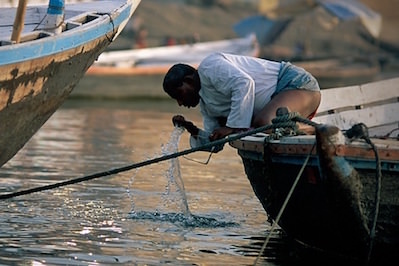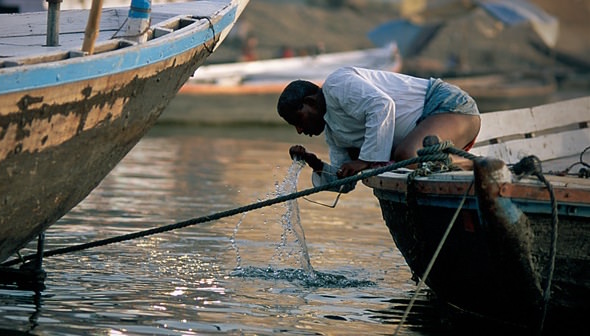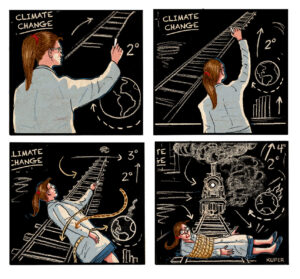Pollution Is Turning Rivers Into Sources of Disease and Death
Human destruction of wilderness areas has added to the pollution that puts millions of people on three continents at risk of waterborne diseases.
By Tim Radford / Climate News Network

Drinking from rivers such as the Ganges in India poses serious health risks. (Jordi Boixareu via Flickr)
LONDON — More than half the rivers of Asia, Africa and Latin America have become more dangerous in the last 20 years, with steep rises in organic and pathogen pollution.
According to a new UN study, more than 300 million people on the three continents are at risk from water-borne diseases. And over the same timespan, according to a separate study, at least 10% of the area considered as wilderness has been destroyed or damaged by humans.
There is a connection: rivers tend to have their source in uninhabited terrain, and wilderness areas are the least likely to carry human infection such as typhoid or cholera, or to become poisoned by human toxic or organic waste.
Rise in pollution
The latest UN Environment Programme report on water quality argues that the “worrying” rise in pollution is a threat to vital food sources and to the economic wellbeing of three continents.
By making access to clean, safe water even more difficult, it has increased global inequality — hitting women, children and the poorest hardest of all.
“Access to quality water is essential for human health and human development, and both are at risk if we fail to stop this pollution,” says Jacqueline McGlade, UNEP chief scientist.
“Luckily, it is possible to begin restoring rivers from becoming contaminated. It is vital the world works together to combat this growing menace.”
Around 3.4 million people die each year from water-borne diseases such as cholera, typhoid, infectious hepatitis, polio, cryptosporidiosis and other infections, and many of these diseases are linked to human excrement in water. In Latin America, 25 million people could be at risk; in Africa, 164 million; and in Asia, 134 million.
“Access to quality water is essential for human health and human development, and both are at risk
if we fail to stop this pollution.”
One of every seven kilometres of all river stretches in the three continents is now affected by severe organic pollution. Saline wastewater from mines, irrigation systems and homes already affects a tenth of all river stretches and makes it even harder for the poorest farmers to irrigate their crops.
Between 1990 and 2010, this increased in almost a third of all rivers on the three continents. More than half of the phosphorus load in 23 out of 25 of the world’s major lakes was delivered by humans from fertilisers, pesticides, livestock waste and human sewage.
But if conservation policies are failing the rivers, they are also failing the mountain regions and forests where the rivers rise.
In a separate study, researchers report in Current Biology journal that, since the early 1990s, 10% of those parts of the inhabited world that were essentially still free of human disturbance have been despoiled.
Lost wilderness
Just over 30 million square kilometers — more than 23% of land surface, excluding Antarctica and other places of lakes, rock and ice — is still wilderness.
But since the early 1990s, an estimated 3.3million sq km has been lost to human invasion — most of it in South America, which has lost 30% of its wilderness, and Africa, which has lost 14%.
“The amount of wilderness lost in just two decades is both staggering and saddening,” says one of the report’s authors, William Laurance, distinguished research professor of environmental science and management at James Cook University in Cairns, Australia.
“International policies are urgently needed to maintain surviving wilderness before it’s too late. We probably have just one or two decades to turn this crisis around,
“Once a wilderness is lost, it almost never comes back. The only option is to proactively protect the wilderness we have left.”
Tim Radford, a founding editor of Climate News Network, worked for The Guardian for 32 years, for most of that time as science editor. He has been covering climate change since 1988.
Your support is crucial...As we navigate an uncertain 2025, with a new administration questioning press freedoms, the risks are clear: our ability to report freely is under threat.
Your tax-deductible donation enables us to dig deeper, delivering fearless investigative reporting and analysis that exposes the reality beneath the headlines — without compromise.
Now is the time to take action. Stand with our courageous journalists. Donate today to protect a free press, uphold democracy and uncover the stories that need to be told.







You need to be a supporter to comment.
There are currently no responses to this article.
Be the first to respond.